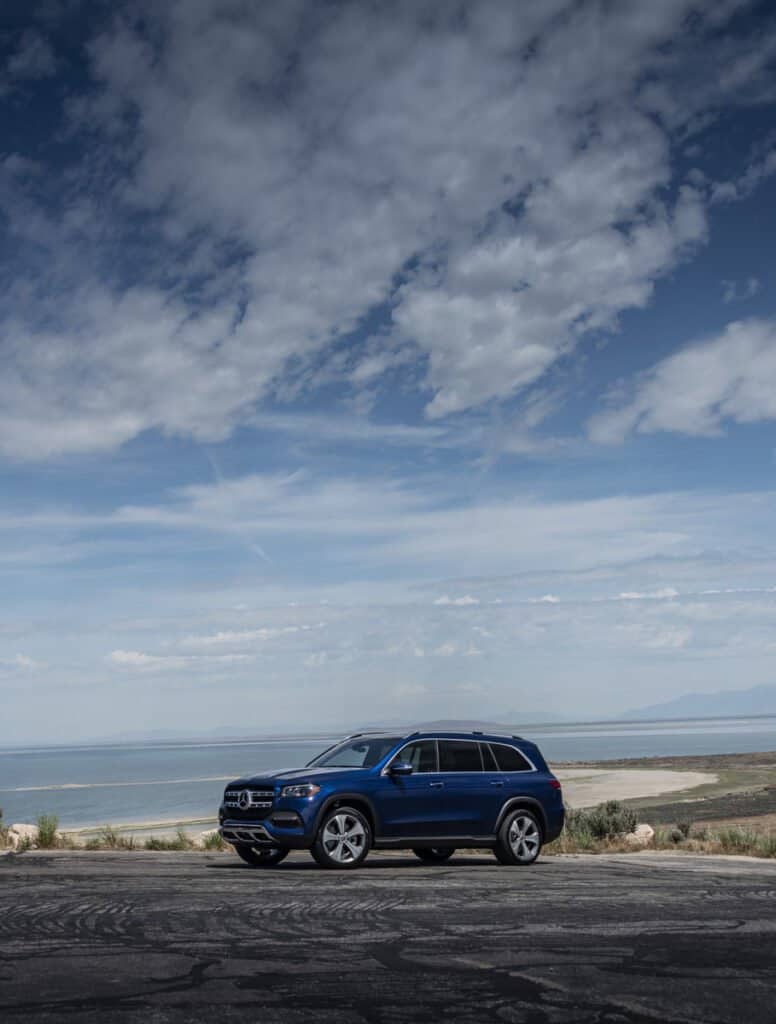What Are The Best Years For The Mercedes-Benz GL Class? (3 Years To BUy!)
If you’re looking for a luxury SUV, one brand immediately comes to mind: Mercedes-Benz. Our article dives into the prime years for one of this brand’s top SUVs and answers what are the best years for the Mercedes-Benz GL Class.
This research is a must-read for those seeking the epitome of elegance in an SUV. Our guide pinpoints the standout models in the GL Class lineup, ensuring you make an informed decision for a superior driving experience.

Though short-lived, the Mercedes Benz GL-Class was the company’s flagship SUV, and, from the start, it came with a clear goal. The GL-Class was to become the S-class for SUVs, which is quite a statement.

“Drive Past Myths: Get the Real Deal on Car Buying!”
🚘 Uncover 13 Car Buying Misconceptions with Our FREE Newsletter!
Plus you will get our quick tips, expert advice, and myth-busting insights delivered straight to your inbox.
Subscribe now and make informed decisions without the detours.
“Experts Hate This! Learn the Car Buying Secrets They Don’t Want You to Know. Free Subscription!”
This SUV was produced from 2006 to 2019 before it became the GLS. This relatively short production run produced some good years, and the best years for the Mercedes-Benz GL-Class were 2008, 2011, and 2016.
The GL-Class has a lot of advantages: it’s large and comfortable, plus, thanks to its heaping amount of safety features, it’s one of the safest SUVs out there, hence a popular choice in the luxury segment. Unfortunately, however, it lacks reliability.
So, what are the best years for the Mercedes-Benz GL-Class?
What are the best years for the Mercedes-Benz GL Class?
The best years for the Mercedes-Benz GL Class are the 2008 and 2011 GL 450, from the first generation, and the 2016 GL400, eventually becoming the GLS400. These years have shown the least amount of issues out of all the models.
However, it’s important to clarify that, in 2016, Mercedes-Benz renamed it from GL to GLS to highlight the luxury status of this SUV. The company, and magazines, therefore, consider those models from 2017 onwards as a separate class.
The GL-Class has many aspects to its advantage. It’s roomy and comfortable, and this remains a constant throughout the years. Even adult passengers can find the third-row seating comfortable.
Also, all the engine options provide enough power to move this massive SUV with ease. This doesn’t mean that it’s a perfect SUV.
The GL-Class suffers from hampered rear visibility, and navigating tight spaces can be quite a challenge. Also, reliability isn’t the strongest with this SUV, especially those with diesel engines.
If you are looking to buy a diesel GL-Class, then there are several aspects that you have to consider. But, first, let’s discuss each generation of GL-Class.
Best Years For THe Mercedes-Benz GL Class: First Generation (X164, 2006-2012)
The first-generation GL-Class came out in 2006 as a direct competitor to the Audi Q7, and other third-row SUVs, like the Escalade and the Lexus LX. However, it did have one advantage: a unibody construction, which gave it better handling.
In addition, all GL-Class models came with the same interior features and the seven-speed transmission with changes happening in the engine department.
So, customers had the assurance of knowing they were buying a complete package, regardless of the engine. The only model that differed was the GL63 AMG version had upgraded looks.
The best years for the first-generation GL-Class are the 2008 and 2011 models. These have shown to be the most reliable, though that’s not to say they are reliable.
The entire GL-Class has bad reviews in Consumer Reports. On the other hand, JD Power rates 2011 as the highest ranking in reliability, followed by the 2008 model. It’s important to note that only one model year, 2014, exceeds the 80-point mark in JD Power, which is unusually low.

What are some common issues with the First-Generation GL-Class:
Common issues with the first-generation GL-Class include transmission issues. Several forums report a clunking noise when shifting.
Also, with vehicles over 90,000 miles, there have been complaints of jarring shifts, especially in lower gears. The 7-speed transmission can feel smooth and helps with fuel economy, but repairs can be expensive once it starts showing issues.
Another issue in the first-generation GL-Class revolves around air suspension. When it’s working correctly, the suspension provides a smooth ride, and the SUV glides over the bumps, even with such a large size.
However, the interior feels bumpy once the kit starts leaking, leading to other components wearing out fast. Also, sensors can fail, leading to inadequate inflation, which can wear out the bags faster than usual.
Finally, the GL-Class’s central computer can drain out the battery fast. If you notice that the battery life is shortening, then it’s best to perform a checkup. This problem can get so bad that batteries drain overnight.
Best Years For The Mercedes-Benz GL Class: Second Generation (X166, 2012-2016)
The second-generation GL-Class entered the market in September 2012, with a revamped interior, more safety features and driver aids, and improved engines. The best year for the second-generation GL class is 2016.
This year offers the most reliability, comfort, and features. As a result, it has the highest ranking in JD Power. While sites such as Kelley Blue Book give this car 4.3 out of 5 in customer satisfaction, experts rate wgith a low 3.5 out of 5.
This shouldn’t come as a surprise, as the GL class hasn’t been able to rank highly in reliability. However, the 2016 model year marked the last of its generation, and came with a series of improvements.
In 2015, Mercedes-Benz updated the engine offer, introducing more power and offering performance worthy of sports cars. The GL500 had a blistering 0-60 time of 5.3 seconds, and the GL63 AMG did it in well below five seconds. Keeping this in mind and considering that the best year is 2016, the engine is up to you.
The GL500 offers power and versatility. However, it’s a thirsty SUV. If you’re looking for fuel economy (considering its size), the GL350 diesel is a good option.
Keep in mind that reliability ratings in diesel Mercedes-Benz vehicles rank consistently low.
The GL63 is an exciting option for those who love performance and don’t mind paying a hefty premium for maintenance. However, thanks to its performance-inspired brakes, engines, and internal components, even oil changes can turn out to be expensive.
What are some common issues with the Second-Generation GL-Class:
Consumers have reported that the 2015 GL500 suffers from misfires, which can lead to costly repairs. Usually, these situations require replacing the cylinder heads. This is an expensive and labor-intensive process that only specialized shops should do. I
f you feel the vehicle lacks power or backfires, it’s essential to check the compression. Most reports indicate that this problem happens above 75,000 miles.
Bi-turbo engines also have a reputation for scarring turbos at around 100,000 miles. The problem is that all the second-generation GL’s gasoline engines come with twin turbos. To avoid buying a lemon, it’s best to check for maintenance records.
Rigorous oil changes are essential for the turbos’ wellbeing, so if there’s no record showing these, it’s best to walk away from said vehicle.

You might be tempted to consider diesel engines, which come with only one turbo. However, if you want a diesel GL-Class, it’s best to check the entire piping system around the radiator.
Diesel GLs are famous for leaking coolant and, if left unattended, can lead to overheating and damaged gaskets. This problem is expected because the GL’s cooling system uses a lot of plastic hoses (instead of rubber), which can crack over time.
If you’re looking to buy a used diesel GL, perform a thorough inspection of the entire cooling system regardless of the year. Cracks are a bad sign, but also, be suspicious of brand-new piping.
This might indicate a recent service to hide damaged components. With diesel engines, it doesn’t hurt to be too cynical.
The GL became the GLS in 2016
From 2016 on, the X166 changed its name to the GLS. Mercedes-Benz chose this change to fulfill the naming change that the entire brand was going through. Though technically it remained the same, sales registries stopped considering the GLS and GL as the same model.
Therefore, it’s essential to make the distinction.
The GLS continued its renewal in 2020 when Mercedes-Benz released the third generation X167.
A longer, sleeker look accompanied by new engines, an improved interior, and better rear visibility. Though it comes with a V8 option, it’s important to note that Mercedes-Benz announced that it will stop selling V8s in the US, beginning in 2022.
Closing thoughts:
The GL-Class is Mercedes-Benz’s flagship SUV. It’s roomy, powerful, and comfortable. Plus, with the varied engine options, there’s something for everyone who’s looking at luxury SUVs.
However, it’s not as reliable as other brands. So, what are the best years for the Mercedes-Benz GL-Class?
This article answers this question and provides you with some of the common issues this SUV can have.

The best years for the Mercedes-Benz GL-Class are the 2008 and 2011 models, for the first generation, and 2016 for the second generation. These years have the least issues and higher reliability ratings.
However, don’t think it’s a reliable SUV. In fact, most years have problems that can lead to expensive repairs. Examples include turbo scarring and transmission wear.
In this article, we also covered how the diesel-powered GL-Class models can have issues with cooling. If this is the problem, it can lead to significant damage to the engine and costly repairs. So if you’re looking to buy a used GL-Class, be sure to perform thorough inspections.
While this SUV is comfortable and powerful, costly repairs can ruin the pleasure of driving it. Hopefully, this article provides all the information you need to find the best GL-Class for you.
